Did you know that over 90% of the Philippines’ historic churches were built during the Spanish colonial period? This remarkable fact highlights the profound influence of Spain on the country’s architectural landscape. From the 16th to the 19th century, Spanish architecture shaped the identity of Philippine cities, leaving behind a legacy that continues to captivate the world.
Spain introduced a unique blend of Mediterranean, Roman, Gothic, and Baroque styles to the Philippines. These elements were adapted to local materials and conditions, creating structures that were both functional and beautiful. The result was a fusion of cultures that defined the urban landscapes of cities like Manila, Vigan, and Cebu.
Today, these architectural marvels stand as testaments to a shared history. They remind us of the cultural exchange between Spain and the Philippines, which shaped not only buildings but also the identity of an entire nation. As we explore this topic further, we’ll uncover how Spanish architecture continues to influence modern designs and urban planning in the Philippines.
Key Takeaways
- Spanish architecture played a key role in shaping Philippine cities.
- It blended Mediterranean, Roman, Gothic, and Baroque styles.
- Historic churches and buildings reflect this cultural exchange.
- Urban landscapes in cities like Manila and Vigan showcase this influence.
- Modern designs in the Philippines still draw inspiration from Spanish architecture.
Historical Overview of Spanish Architectural Evolution
Spain’s architectural history is a tapestry woven with diverse influences and innovations. From the Roman conquest to the Islamic golden age, each era left its mark on the country’s building styles. This rich history reflects centuries of cultural exchange and artistic evolution.
From Roman Conquest to Islamic Influences
The Roman era introduced sturdy structures like aqueducts and amphitheaters. These designs emphasized durability and functionality. By the 8th century, Islamic rule brought intricate geometric patterns and ornate decorations. This fusion of styles created a unique aesthetic that still defines many Spanish landmarks today.
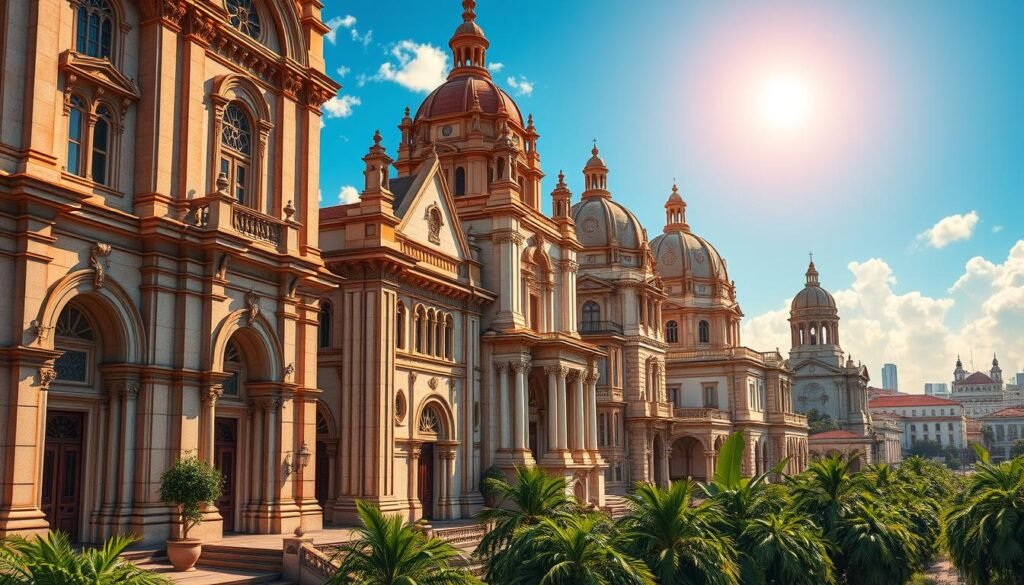
Medieval Traditions and the Rise of Renaissance Styles
During the Medieval period, Gothic cathedrals with pointed arches and tall spires became prominent. These structures symbolized both faith and power. By the 15th century, the Renaissance introduced a return to classical art and symmetry. This era marked a shift toward elegance and proportion in design.
Each phase of Spain’s architectural journey reflects the cultural and technological advancements of its time. These influences laid the foundation for modern designs, as explored in this detailed analysis.
Defining Spanish Architecture: Signature Elements and Influences
What makes Spanish architecture stand out among global styles? Its unique charm lies in a blend of cultural influences and practical design elements. From intricate arches to ornate facades, this style has left an indelible mark on the world.
One defining element is the use of arches, which add both beauty and structural support. These arches often feature decorative motifs, reflecting Islamic and Gothic contributions. Another hallmark is stucco work, which gives buildings a smooth, timeless finish.
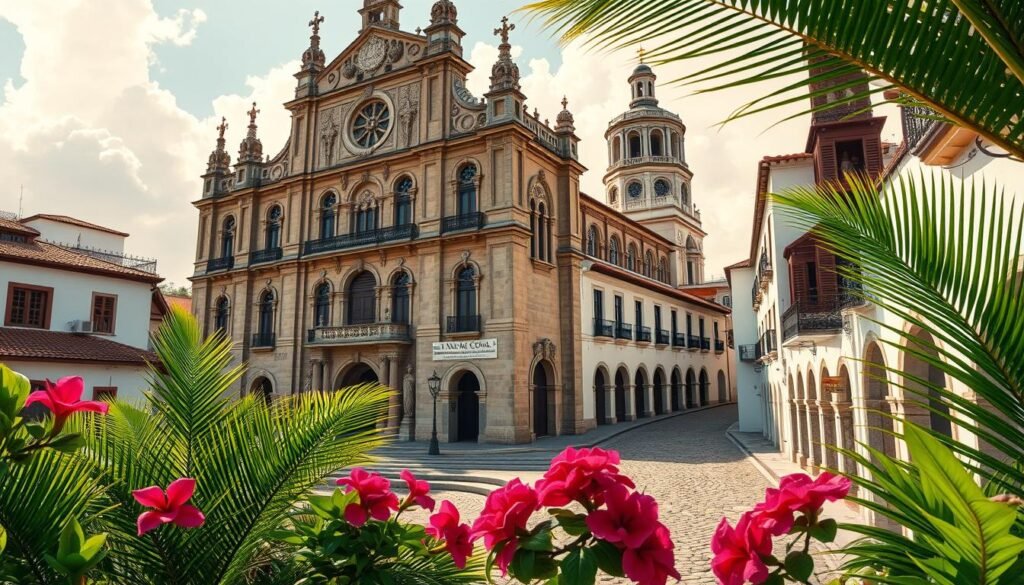
Spanish architecture also incorporates columns and clay roof tiles, blending functionality with artistry. For example, the Alhambra in Granada showcases these features, with its detailed carvings and serene courtyards. These structures highlight the seamless fusion of practicality and aesthetics.
The term architecture spain encompasses both traditional and modern applications. While historic buildings reflect centuries of cultural exchange, contemporary designs continue to draw inspiration from these timeless elements. This enduring legacy ensures that Spanish architecture remains a source of inspiration worldwide.
The Cultural Legacy of Spanish Colonial Influence in the Philippines
The Philippines’ urban landscapes tell a story of cultural fusion and adaptation. Over centuries, colonial rule shaped the country’s cities, blending foreign styles with local traditions. This unique mix is still visible today, especially in historic districts and religious structures.
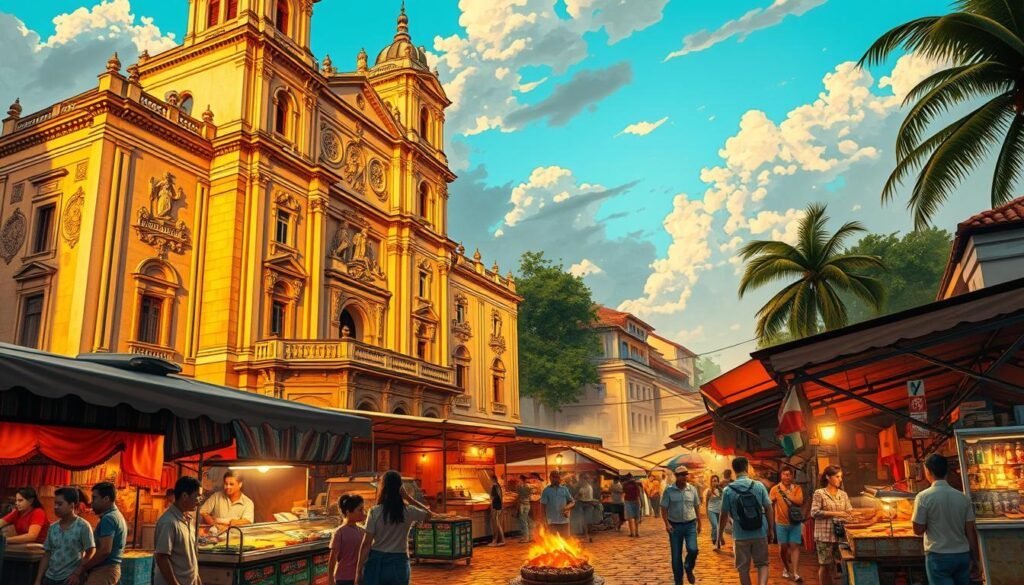
Architectural Adaptations in Colonial Urban Centers
Colonial urban planning introduced new designs to the Philippines. Structures were adapted to suit the tropical climate, using local materials like wood and stone. Churches, such as the San Agustin Church in Manila, became central to community life. These buildings not only served religious purposes but also symbolized colonial authority.
Civic structures, like town halls and plazas, were designed to reflect European styles. However, they incorporated local craftsmanship and decorative elements. This blend of styles created a unique architectural identity that continues to define Philippine cities.
Fusion of Spanish and Indigenous Design Elements
The fusion of styles is most evident in religious and civic buildings. Spanish decorative elements, like intricate carvings and arches, were combined with indigenous motifs. For example, local artisans often added floral patterns and geometric designs to church facades.
This blending of traditions extended to construction methods. Local techniques, such as using bamboo and thatch, were integrated into colonial designs. The result was a harmonious mix that honored both cultures.
“The fusion of styles in the Philippines is a testament to the resilience and creativity of its people.”
Today, these colonial structures stand as symbols of a shared history. They remind us of the enduring influence of cultural exchange on the Philippines’ urban fabric. From churches to town plazas, the legacy of this fusion continues to shape the country’s identity.
Urban Transformation: Spanish Imprints on Philippine Cityscapes
The streets of Philippine cities whisper tales of a colonial past, where Spanish design left an indelible mark. From the cobblestone paths of Vigan to the bustling plazas of Manila, the influence of colonial-era planning is still evident. These urban spaces reflect a blend of functionality and artistry, shaped by centuries of cultural exchange.
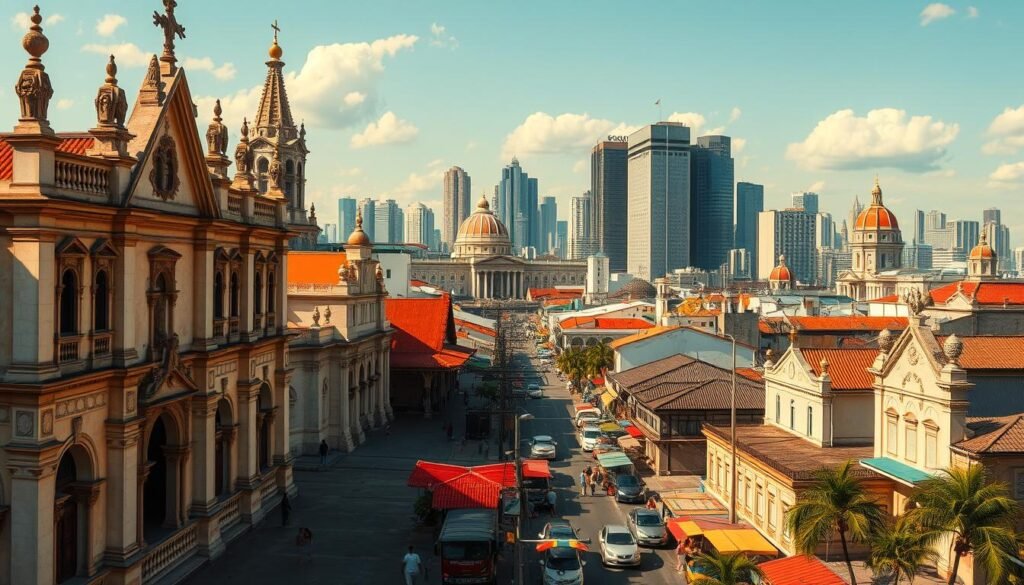
Today, efforts to revitalize historic districts are breathing new life into these colonial treasures. Restoration projects focus on preserving the authenticity of structures while adapting them for modern use. Traditional construction techniques, such as the use of brick and coral stone, are being revived to maintain the integrity of these buildings.
Historic District Revitalization
In cities like Cebu and Iloilo, colonial-era buildings are being restored to their former glory. These projects aim to protect the cultural heritage while promoting tourism and economic growth. The use of local materials and craftsmanship ensures that the restored structures remain true to their origins.
Urban planning today benefits from the colonial-era street layouts and plazas. These designs promote walkability and community interaction, creating vibrant public spaces. The integration of green areas and modern amenities enhances the livability of these historic districts.
| City | Key Features | Restoration Efforts |
|---|---|---|
| Vigan | Cobblestone streets, ancestral houses | UNESCO World Heritage Site, ongoing preservation |
| Manila | Intramuros, colonial churches | Public-private partnerships for restoration |
| Cebu | Fort San Pedro, heritage homes | Community-led conservation projects |
Despite the successes, challenges remain in preserving the authentic character of these districts. Balancing modernization with heritage conservation requires careful planning and community involvement. The revitalization of these areas showcases the enduring legacy of Spanish influence in the Philippines.
For more insights into the cultural exchange between Spain and the Philippines, explore this detailed analysis.
Architectural Components: Materials, Motifs, and Structural Design
From ancient times, the choice of materials has played a pivotal role in shaping architectural styles. The use of brick, stucco, and red clay roof tiles has defined the exteriors of countless structures. These elements not only provide durability but also add a timeless aesthetic appeal.
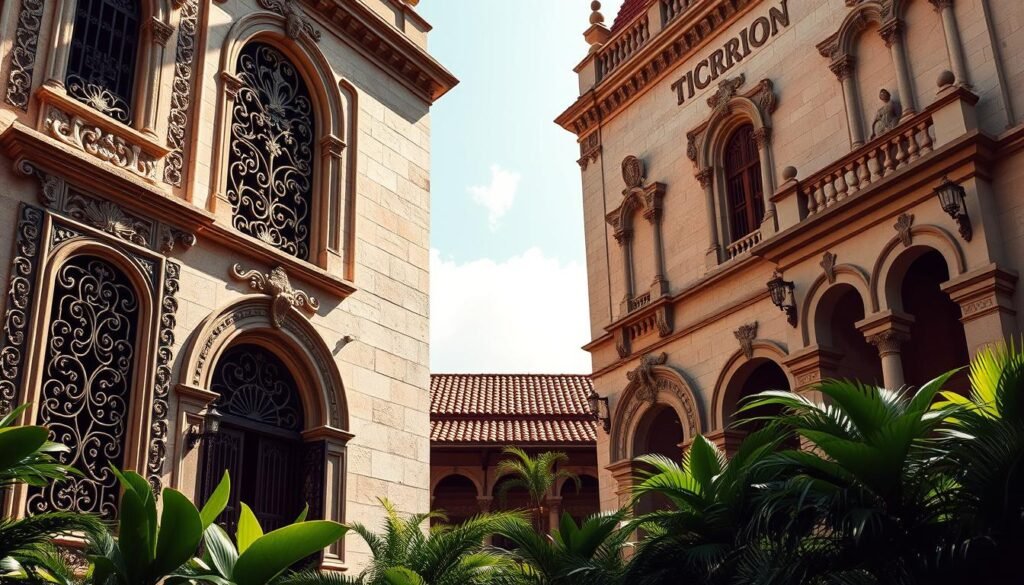
Brick has been a cornerstone of construction for centuries. Its versatility allows it to be used in everything from walls to decorative facades. Stucco, on the other hand, offers a smooth finish that enhances the visual appeal of buildings. Red clay roof tiles, known for their durability, are a hallmark of traditional designs.
Use of Brick, Stucco, and Red Clay Roof Tiles
Brick structures are known for their strength and longevity. The Alhambra in Granada, for example, showcases intricate brickwork combined with stucco finishes. This combination creates a balance between functionality and artistry.
Stucco is often used to give buildings a polished look. It also serves as a protective layer against weather conditions. Red clay roof tiles, with their earthy tones, blend seamlessly with natural surroundings. These tiles are not only practical but also add a rustic charm to structures.
Baroque Ornamentation and Modern Minimalism
The Baroque period was marked by heavy ornamentation and elaborate details. Buildings from this era often feature intricate carvings and decorative motifs. These elements reflect the artistic and cultural values of the time.
In contrast, modern designs lean toward minimalism. Clean lines and simple forms dominate contemporary architecture. Glass is increasingly used to create open, light-filled spaces. This shift highlights the evolution from ornate to functional designs.
“The fusion of durability and decorative innovation has always been a defining feature of construction practices.”
Structural components like towers and walls play a crucial role in defining a building’s character. Towers often serve as focal points, while walls provide both support and privacy. Glass elements, on the other hand, bring transparency and modernity to designs.
| Material | Role | Example |
|---|---|---|
| Brick | Structural support, decorative facades | Alhambra, Granada |
| Stucco | Smooth finish, weather protection | Traditional Mediterranean homes |
| Red Clay Tiles | Roofing, rustic charm | Historic churches in the Philippines |
These materials and design elements continue to influence modern practices. They remind us of the enduring legacy of traditional construction methods. Whether in historic landmarks or contemporary buildings, these components create a distinctive look that stands the test of time.
Modern and Contemporary Adaptations of Spanish Colonial Design
The fusion of traditional and modern design has reshaped urban landscapes in fascinating ways. From the 20th century to today, architects have found innovative ways to blend historical elements with cutting-edge technology. This evolution is particularly evident in projects that honor colonial legacies while meeting modern needs.
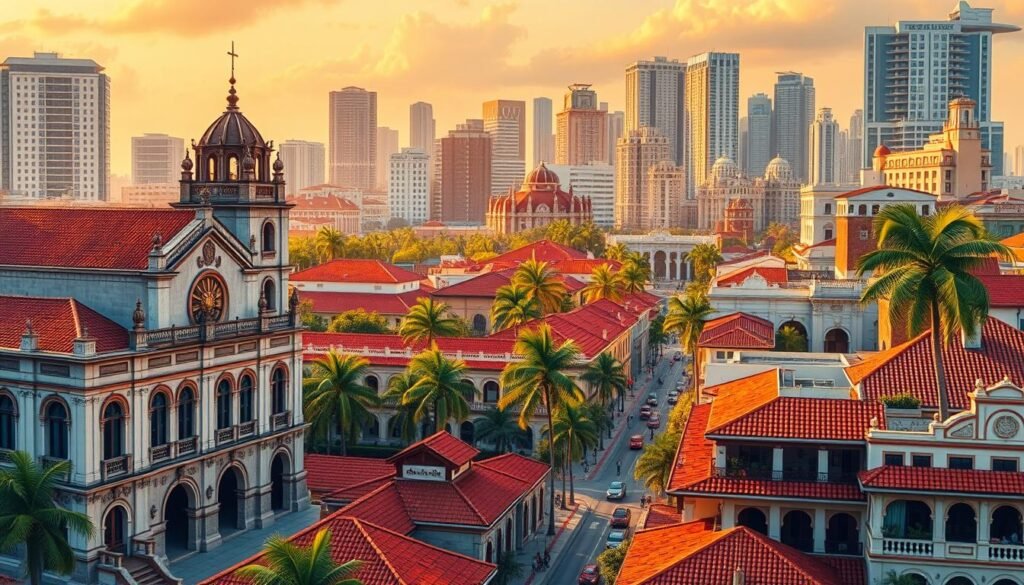
Innovative Renovations in Urban Settings
Urban centers are witnessing a revival of historic structures through creative renovations. For example, in Barcelona, the works of Antoni Gaudí continue to inspire modern designs. His use of organic shapes and vibrant colors has been reinterpreted in contemporary projects, blending tradition with innovation.
Case studies from cities like Manila and Cebu showcase how colonial-era buildings are being repurposed. These projects often retain original facades while introducing modern interiors. This approach not only preserves history but also enhances functionality for today’s urban dwellers.
Sustainable Practices and Adaptive Reuse
Sustainability is at the heart of many modern design projects. Adaptive reuse, where old structures are transformed for new purposes, is gaining popularity. This practice reduces waste and preserves cultural heritage.
For instance, the use of local materials and energy-efficient systems is becoming standard in renovations. In Barcelona, architects are incorporating green technologies into historic buildings, creating a balance between preservation and progress.
“The blend of tradition and innovation ensures that our architectural heritage remains relevant in a rapidly changing world.”
- Examine how 20th century design principles are merged with colonial legacies.
- Detail case studies of innovative renovations in urban environments.
- Discuss sustainable building practices and adaptive reuse in contemporary projects.
- Highlight the influence of renowned architects like Gaudí in modern reinterpretations.
- Reference the role of Barcelona as a hub for avant-garde design.
The dynamic nature of design ensures that traditional elements are continually repurposed using modern technology and materials. This ongoing evolution reflects the resilience and creativity of architects worldwide.
Influential Figures Shaping Spain’s Architectural Heritage
The legacy of Spain’s architectural brilliance is deeply rooted in the contributions of its visionary architects. From historic masters to modern innovators, these figures have left an indelible mark on the world of design. Their work continues to inspire and shape the way we think about art and architecture.
Historic Masters and Their Global Impact
One of the most iconic names in architectural history is Antoni Gaudí. Known for his imaginative designs, Gaudí’s work in Barcelona, such as the Sagrada Família, has become a symbol of creativity and innovation. His use of organic shapes and vibrant colors redefined what was possible in design.
Gaudí’s influence extends far beyond Spain. His unique approach to blending natural forms with structural elements has inspired architects worldwide. As one expert noted, “Gaudí’s work is a testament to the power of imagination in shaping the built environment.”
Modern Visionaries Bridging Past and Present
Today, architects like Santiago Calatrava and Rafael Moneo are carrying forward this legacy. Calatrava’s futuristic designs, such as the City of Arts and Sciences in Valencia, showcase a seamless blend of tradition and modernity. Moneo, on the other hand, is celebrated for his ability to reinterpret historical styles in contemporary contexts.
These modern visionaries are not just building structures; they are creating spaces that tell stories. Their work reflects a deep respect for the past while embracing the possibilities of the future.
“The blend of tradition and innovation ensures that our architectural heritage remains relevant in a rapidly changing world.”
Museums play a crucial role in preserving and showcasing this rich heritage. Institutions like the Guggenheim Museum in Bilbao curate exhibitions that highlight the evolution of design. They serve as a bridge between the past and the present, offering insights into the minds of these influential figures.
For a deeper dive into the contributions of Spain’s architectural giants, explore this detailed analysis. Their work continues to shape the way we live, work, and interact with our surroundings, proving that great design is timeless.
Interplay Between Spanish and Local Architectural Traditions
Colonial-era designs in the Philippines reflect a harmonious blend of foreign and indigenous influences. This fusion of styles has created a unique architectural style that continues to define the country’s urban landscapes. From churches to civic buildings, the synthesis of Spanish and local traditions is evident in both form and function.
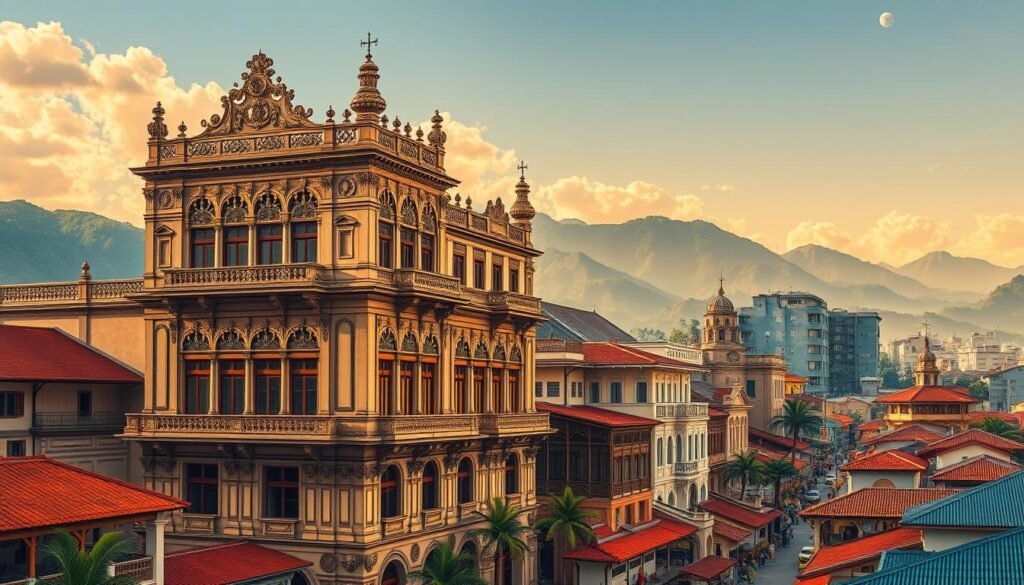
Incorporating Indigenous Cultural Elements
One of the most striking aspects of this cultural exchange is the integration of indigenous motifs into classical Spanish forms. For example, local artisans often added floral patterns and geometric designs to church facades. These elements not only enhanced the aesthetic appeal but also symbolized the blending of two distinct cultures.
Traditional construction techniques, such as the use of bamboo and thatch, were also incorporated into colonial designs. This adaptation ensured that structures were well-suited to the tropical climate while maintaining their artistic integrity. The result was a seamless fusion of practicality and beauty.
Hybrid Aesthetics in Religious and Civic Structures
Religious buildings, such as the San Agustin Church in Manila, are prime examples of this hybrid design. These structures feature intricate carvings and arches, typical of Spanish baroque styles, combined with local craftsmanship. The interplay of these elements creates a visual narrative of cultural exchange.
Civic structures, like town halls and plazas, also reflect this blend. European layouts were adapted to include local materials and decorative motifs. This approach not only preserved the authenticity of the designs but also reinforced the cultural identity of the communities they served.
“The fusion of styles in the Philippines is a testament to the resilience and creativity of its people.”
Today, these colonial-era buildings stand as symbols of a shared history. They remind us of the enduring influence of cultural exchange on the Philippines’ urban fabric. For more insights into this architectural legacy, explore this detailed analysis.
Preservation and Restoration of Spanish-Era Structures
Preserving the past is not just about saving buildings; it’s about safeguarding a nation’s identity. In the Philippines, efforts to restore Spanish-era structures are a testament to the country’s rich cultural heritage. These projects aim to protect historic landmarks while adapting them for modern use.
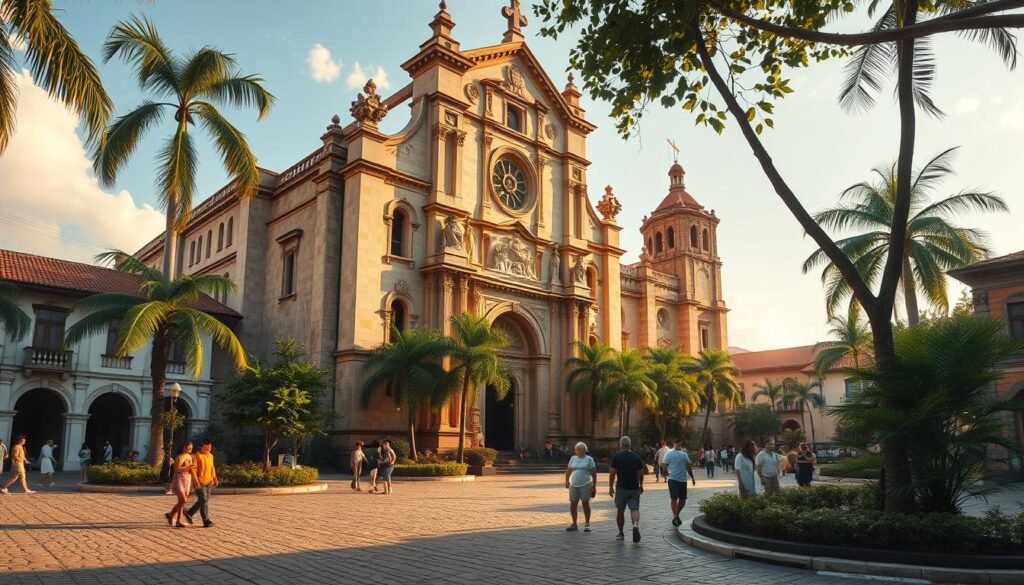
Government and Community Conservation Initiatives
The Philippine government has taken significant steps to preserve its architectural heritage. The National Cultural Heritage Act mandates the protection of buildings over 50 years old. This law ensures that historic structures are maintained for future generations.
Community-led initiatives also play a crucial role. Local groups often collaborate with experts to restore churches and other landmarks. These projects not only preserve history but also boost tourism and local economies.
Challenges in Preserving Heritage Buildings
Restoring historic structures comes with unique challenges. One major issue is the degradation of original materials. Over time, bricks, wood, and stucco can deteriorate, making restoration costly and time-consuming.
Environmental factors, such as humidity and earthquakes, also pose risks. Additionally, balancing modern needs with historical authenticity requires careful planning. Despite these hurdles, many projects have successfully blended old and new techniques.
“The fusion of tradition and innovation ensures that our architectural heritage remains relevant in a rapidly changing world.”
One notable example is the restoration of the San Agustin Church in Manila. This project used traditional construction methods to maintain the building’s integrity. Similarly, the tower of the Manila Central Post Office was restored after a devastating fire, showcasing the resilience of these historic structures.
For more insights into how adaptive reuse is transforming historic buildings, explore this detailed analysis. These efforts remind us that preserving the past is essential for shaping the future.
Architectural Tourism: Exploring Spain’s Colonial Footprint in the Philippines
Exploring the Philippines offers a unique journey through time, where colonial landmarks tell stories of a shared past. Architectural tourism has gained momentum, allowing visitors to experience the rich history and design of Spanish-era structures firsthand. From cobblestone streets to grand churches, these sites provide a glimpse into the country’s cultural evolution.
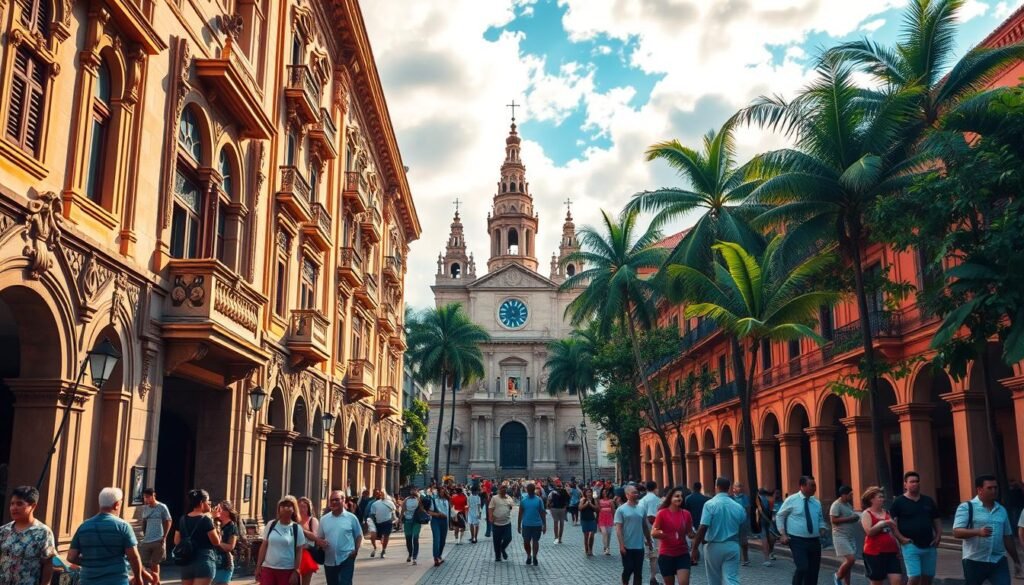
Cultural Trails and Heritage Walks
Cultural trails and heritage walks have become popular ways to explore the Philippines’ colonial legacy. Cities like Manila, Vigan, and Cebu offer guided tours that highlight preserved sites. These walks not only showcase architectural marvels but also connect visitors to the stories behind them.
For example, the San Agustin Church in Manila is a must-visit. Its intricate carvings and Baroque style reflect the fusion of Spanish and local influences. Walking through its halls feels like stepping back in time.
Museums as Gateways to the Past
Museums play a crucial role in enhancing visitor understanding of colonial design and art. Exhibits often feature artifacts, blueprints, and interactive displays that bring history to life. The National Museum of the Philippines, for instance, offers insights into the country’s architectural evolution.
These institutions serve as educational hubs, bridging the gap between the past and present. They help visitors appreciate the craftsmanship and cultural significance of colonial structures.
Urban History and Modern Tourism
The relationship between urban history and modern tourism is evident in cities like Vigan. Its well-preserved colonial district attracts visitors from around the world. Efforts to revitalize these areas have boosted local economies while preserving cultural heritage.
Government and community initiatives have been instrumental in promoting these attractions. By balancing preservation with modern needs, they ensure that these landmarks remain relevant for future generations.
“Architectural tourism not only celebrates the past but also fosters a deeper appreciation for cultural heritage.”
For more on the Philippines’ colonial history, explore this detailed analysis. These efforts remind us that preserving the past is essential for shaping the future.
Spanish Mission Architecture: Influence Beyond Spain
The enduring legacy of Spanish mission design has shaped landscapes far beyond its origins. Rooted in the 16th century, this style emerged as a blend of practicality and artistry, designed to withstand harsh climates while reflecting cultural and religious values. Its influence extends across the United States and Mexico, where it has been adapted to local traditions and environments.
From Classic Missions to Modern Home Design
Classic Spanish mission architecture is defined by its distinctive features. White stucco walls, red clay roof tiles, and decorative archways are hallmarks of this style. These elements were not only functional but also symbolic, representing the fusion of European and indigenous cultures.
In the United States, this style became particularly popular in warmer regions like California and the Southwest. Adobe walls and clay tiles were ideal for the climate, providing insulation and durability. Today, these features are still celebrated in modern home design, blending tradition with contemporary needs.
Regional Variations in Architectural Adaptations
In Mexico, Spanish mission elements were adapted to reflect local craftsmanship and materials. Indigenous motifs and techniques were incorporated into church facades and civic buildings, creating a unique hybrid style. This blending of traditions is evident in structures like the San Xavier del Bac Mission in Arizona.
Regional variations also reflect environmental factors. In arid regions, thick adobe walls and clay tiles were essential for temperature control. In contrast, coastal areas often featured open courtyards and breezy layouts to maximize airflow.
“The fusion of Spanish mission elements with local traditions has created architectural identities that are both functional and beautiful.”
For more insights into the evolution of this style, explore this detailed analysis. The cross-cultural impact of Spanish mission architecture continues to shape building trends today, proving its timeless appeal.
Conclusion
The fusion of styles in Philippine cities reflects a rich cultural exchange. From the baroque churches to modern urban planning, the influence of colonial design remains a vital part of the country’s identity. This blend of traditions showcases the resilience and creativity of its people.
Efforts to preserve historic structures highlight the importance of safeguarding cultural heritage. Restoration projects in cities like Manila and Vigan demonstrate how construction techniques from the past can be adapted for modern use. These initiatives ensure that the legacy of colonial design continues to inspire future generations.
Influential figures like Antoni Gaudí have left a lasting impact on architectural movements worldwide. Their work serves as a bridge between history and innovation, reminding us of the enduring value of cultural exchange. For more insights, explore this detailed analysis.
As we look to the future, the principles of colonial design will continue to shape urban landscapes. By blending tradition with modern needs, Philippine cities can honor their past while embracing progress. This ongoing evolution ensures that architectural heritage remains a cornerstone of cultural identity.
FAQ
How did Spanish colonial architecture influence Philippine cities?
Spanish colonial architecture introduced elements like plazas, churches, and fortifications, shaping the urban layout of Philippine cities. These designs blended European styles with local materials and traditions.
What are the key characteristics of Spanish architectural styles?
Key features include the use of brick, stucco, and red clay roof tiles, along with ornate Baroque details and symmetrical layouts. These elements reflect both functionality and aesthetic appeal.
How did Spanish and indigenous design elements merge in the Philippines?
Spanish designs adapted to local climates and materials, incorporating indigenous motifs and techniques. This fusion created unique hybrid structures in religious and civic buildings.
What role did Baroque ornamentation play in Spanish architecture?
Baroque ornamentation added grandeur and intricacy to buildings, emphasizing dramatic details and religious symbolism. This style became a hallmark of many colonial-era churches and public structures.
How are Spanish-era buildings preserved in the Philippines today?
Preservation efforts involve government initiatives, community projects, and adaptive reuse strategies. These aim to maintain historical integrity while repurposing structures for modern use.
What is the significance of Spanish mission architecture outside Spain?
Spanish mission architecture influenced regions like the Americas, blending religious and functional designs. Its legacy continues in modern adaptations and regional variations.
How does Spanish colonial design inspire contemporary architecture?
Modern architects draw from colonial aesthetics, incorporating elements like courtyards and arched windows. Sustainable practices and adaptive reuse also reflect this enduring influence.
Who were some influential figures in shaping Spain’s architectural heritage?
Historic masters like Antoni Gaudí and modern visionaries such as Santiago Calatrava have left a lasting impact. Their works bridge traditional styles with innovative designs.
What are some examples of Spanish architectural tourism in the Philippines?
Cultural trails and heritage walks in cities like Manila and Vigan showcase colonial-era churches, plazas, and ancestral homes, offering insights into the shared history.
How did Spanish architecture adapt to different regions globally?
Spanish designs evolved to suit local climates and cultures, resulting in unique regional styles. Examples include the missions in California and colonial structures in Latin America.
Source Links
- History of Philippine Architecture – National Commission for Culture and the Arts
- Spanish Colonial architecture
- Spain – Architecture, Gothic, Baroque | Britannica
- The Development of Architecture in New Spain, 1500–1810
- What Is Spanish Colonial Architecture? All the Defining Details
- Spanish Architecture – Exploring the Most Famous Architecture in Spain
- Spanish Colonial Influences on Filipino Culture
- Philippines – Spanish Colonization, Culture, Trade | Britannica
- The Spanish Influence on Filipino Culture and Language
- Sustainable Architecture In The Philippines
- MONU – News
- Everything You Need to Know About Spanish Architecture
- Spanish architecture
- What Makes Modern Spanish Architecture | Crown Asia
- Impact of Spanish Architecture on Philippine Buildings – Richest Philippines
- Antoni Gaudi | Biography, Sagrada Familia, Works, Buildings, Style, & Facts | Britannica
- 5 jewels of Spanish Architecture, by Trafalgar Travel Director
- Reimagining Spanish Architecture: A Fusion of Tradition and Innovation 🏛️✨
- Spanish Colonial Architecture: An Exploration of Style
- Spanish Colonial: Architecture & History
- Historic preservation of Spanish architecture in the Philippines
- Restoration as a Method of Revalorizing Built Heritage in Spain
- The Struggle to Save the Philippines’ Architectural Heritage
- Spanish Colonial Missions Architecture and Preservation (U.S. National Park Service)
- Spanish Empire
- What Is Spanish Architecture?
- The Significance of Spanish Colonial Missions in our National Story and our Common Heritage with Spain, Mexico and Latin America – Spanish Missions/Misiones Españolas (U.S. National Park Service)
- The Influence of Spanish Architecture on Modern Mexican Cities
- " A Research Study on the Architectural Influences from the Spanish Colonial Period and the Road to a Modern Minimalist Design in the Philippines "
- 8 Defining Features of Spanish Architecture

